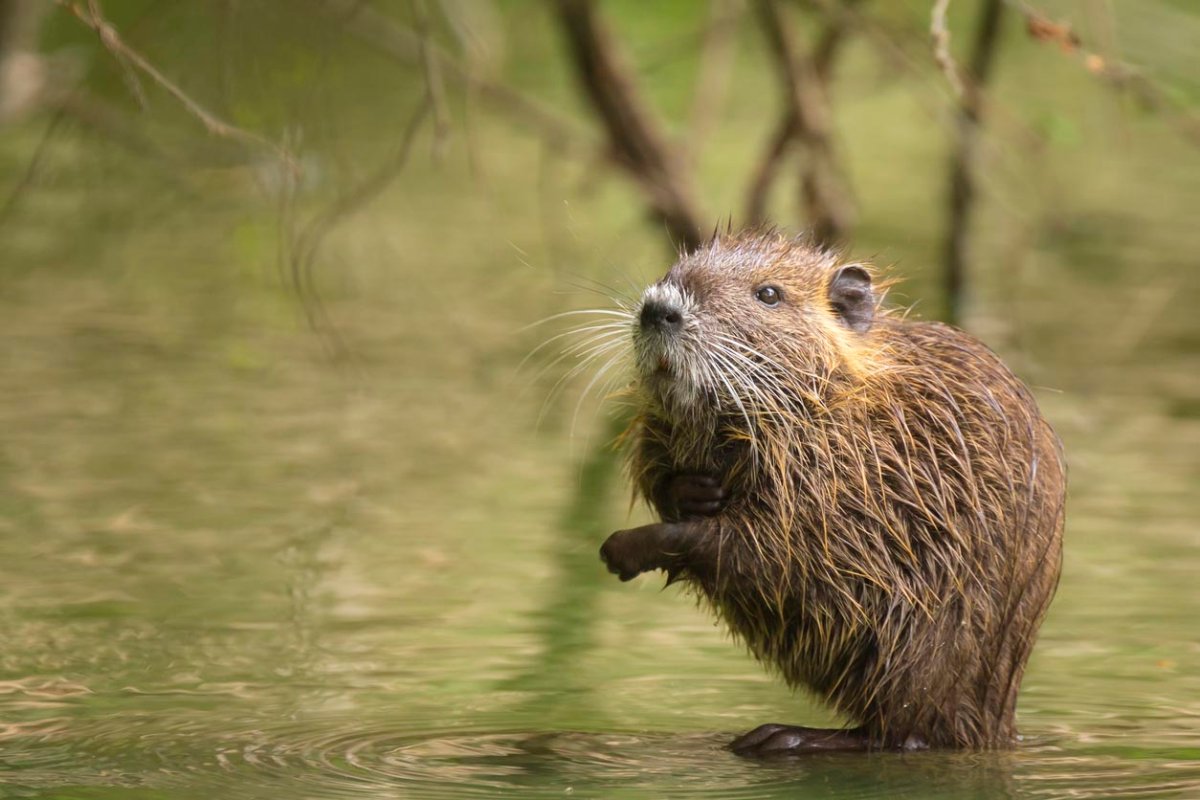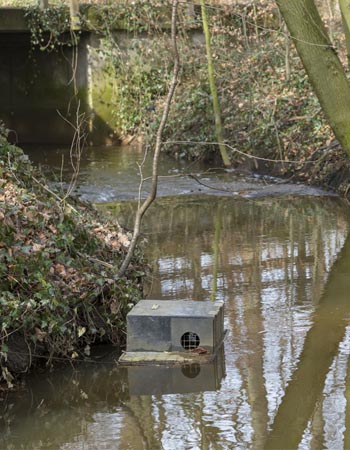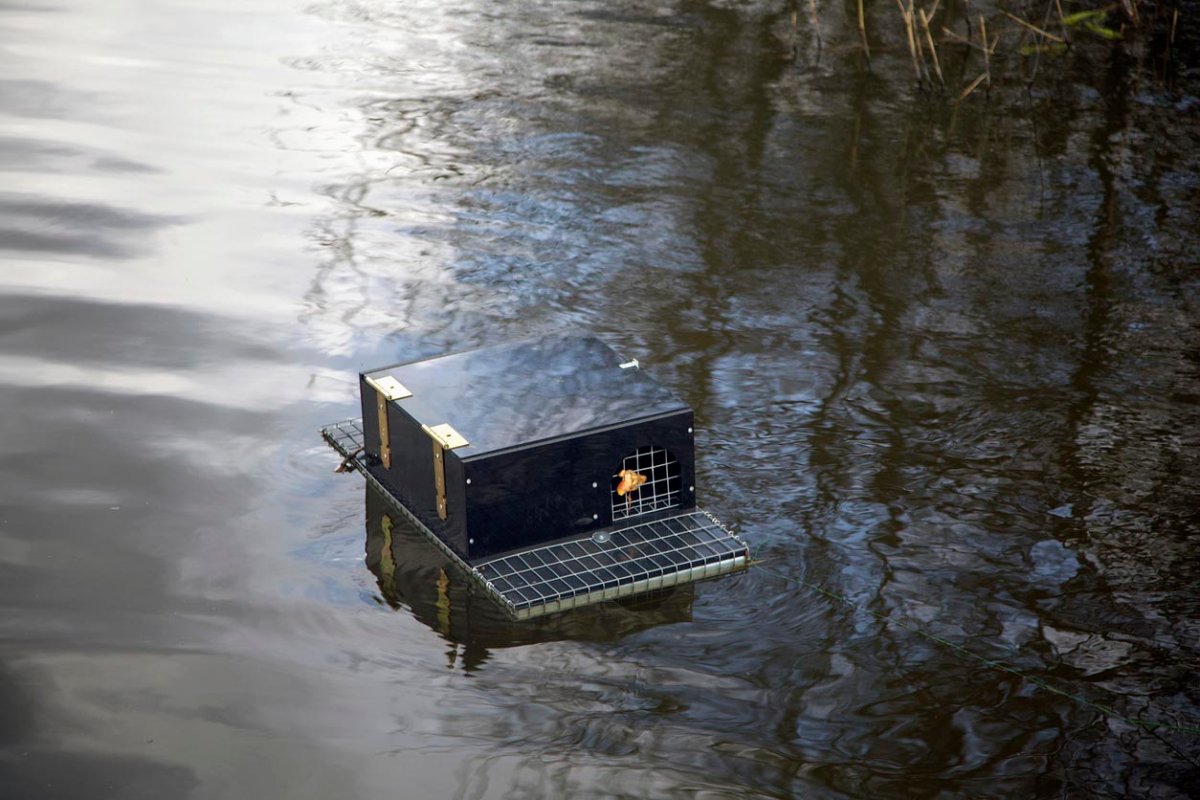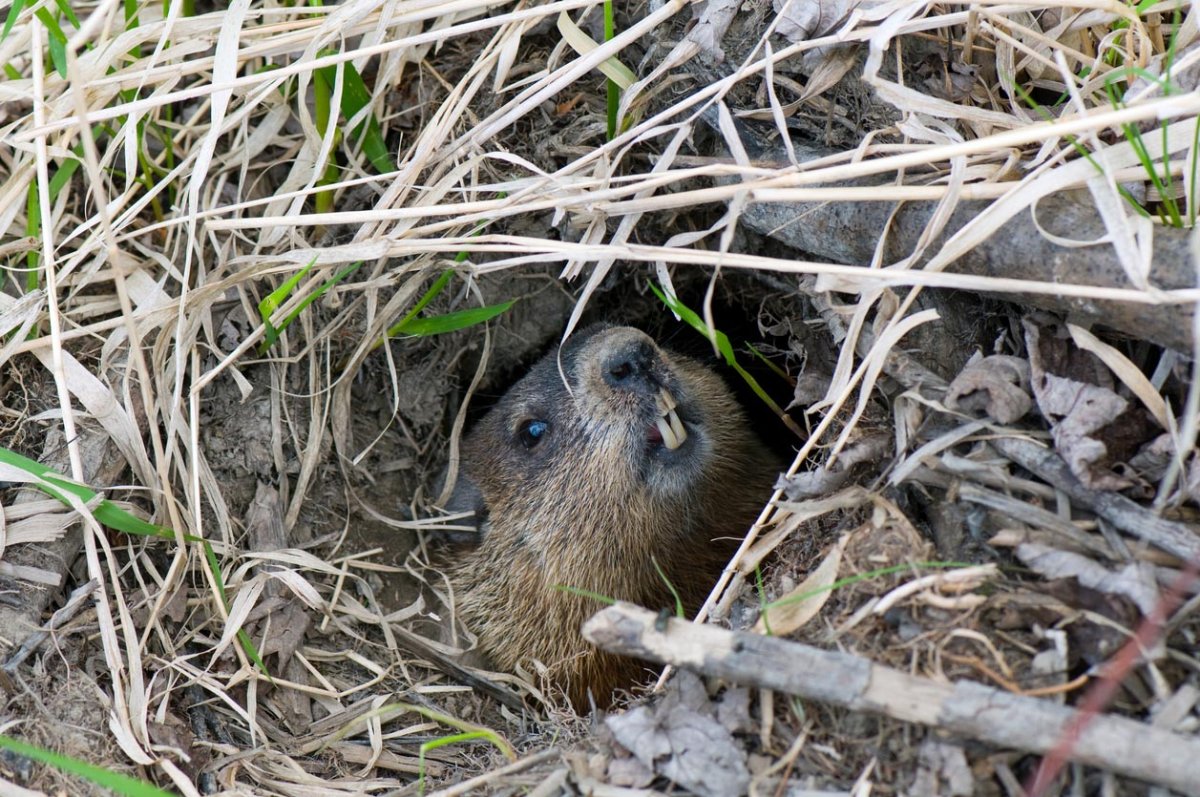

We may earn revenue from the products available on this page and participate in affiliate programs. Learn More ›
Project Overview
- It’s important to use caution when dealing with muskrats, as these animals may carry disease and can become aggressive when threatened.
- Exclusion and deterrent methods can be effective and are worth trying before resorting to physical removal.
- DIY muskrat removal methods include reducing plants that are attractants, applying scent repellents, installing electronic repellents, fencing your property, installing a pond liner, filling burrows, and live trapping.
- For the best and quickest results, have a wildlife removal specialist humanely remove muskrats from the property.
Muskrats may look cute at first glance, but the damage they can do to the banks of ponds and waterways isn’t cute. Furthermore, it can make a lovely waterside property into a hazard. Muskrats are almost universally regarded as pests. They don’t function in a way that offers any benefit to a property, and they can do tremendous damage. While muskrats aren’t generally aggressive, like most animals they may fight back if cornered or they feel threatened. If they are burrowing and digging on your property, however, it’s important to immediately take action before the property becomes badly damaged or a larger population moves in. Removing muskrats may take more than one approach, whether it’s reducing what is attracting muskrats, using repellents, putting in fencing and pond liners, filling burrows, or as a last resort, live trapping. While determining how to get rid of muskrats can begin as a DIY project, in the end it may become necessary to call one of the best wildlife removal services (such as Critter Control or Trutech) to provide assistance.
Tools & Materials
Bobvila.com may earn a commission from purchases made through these links.
Signs of Muskrat Damage

The most obvious signs of muskrat damage are the trails located above their burrows. According to the Animal and Plant Health Inspection Service (APHIS), the entrances to muskrat dens are located between 6 and 12 inches beneath the surface of a body of water, and the den itself is visible only as a dome of pushed-up brush or vegetation. Once they have a den established, muskrats will dig tunnels fanning out from the initial den to create other “rooms” and multiple entrances to the den structure, spreading out as much as 735 feet. This can severely weaken the structure of the bank, causing collapse should someone walk over it or if the water becomes rough, and these tunnels can damage the root systems of trees and vegetation. What is visible on the surface is a raised lump of plant matter atop a hollowed-out den, also called a lodge, pushing up out of the water’s edge.
Droppings may be found on the property near food sources such as gardens or vegetation, but the droppings may be far from the actual burrows and hard to spot. Tracks, scratch and chew marks on trees and shrubs near water, and partly eaten water plants are all suggestions that muskrats are nearby. Finally, muskrats got their common name from the deep, musky scent they produce to mark their territory, so the sweet, slightly thick smell is an indication that muskrat burrows may be nearby. Overall, muskrat damage is fairly simple to identify, but if you have any doubt, a wildlife technician will be able to identify the nature of the pest problem in your garden.
Before You Begin…
If the muskrats in your area aren’t doing damage, it can be safe to leave them alone if they aren’t near areas where pets or children play. Muskrats aren’t typically aggressive toward humans, but if you’re wandering into their territory and disrupting their habitats, it’s possible they’ll get defensive. They’re not common carriers of rabies, but they can carry other diseases such as giardia, so it’s important to exercise caution if you’re dealing with living or dead muskrats.
There are many DIY pest control options on the market. It’s important to bear in mind, though, that using poisons will result in dead animals on the property carrying the poison. This may be ingested by pets or other beneficial animals, which can cause illness or death. For this reason, it’s best to stick to other methods of removing the muskrats whenever possible.
Finally, it’s wise to check state laws about removing, relocating, trapping, or killing muskrats. While most states categorize them as pests that can be killed or relocated because they are fur-bearing, different states have different rules governing what homeowners can and can’t do.
Tips for Getting Rid of Muskrats
- Before attempting to physically remove the muskrats, take steps to make the property as inhospitable as possible so they don’t return.
- When relocating muskrats, remember to take them at least 10 miles from the property to make it difficult for them to return.
Safety Considerations
- Use caution when walking around areas where suspected burrows and dens may be, as the ground may be unstable and could collapse.
- Wear gloves and protective gear when approaching or handling muskrats.
- If it becomes evident that there’s a significant infestation, it’s a good idea to call in an expert for help.
7 Most Effective DIY Muskrat Removal Methods
The most effective way to deal with muskrats is professional removal. However, there are a few methods property owners can try on their own first. For DIY purposes, it’s best to implement a multipronged approach that includes making the area less attractive to the animals, annoying them, and eventually trapping and relocating if necessary.
1. Reduce muskrat attractants on the property such as cattails, willows, and water lilies.
Muskrats are omnivores, so they’ll eat whatever they can find. Edible plants, however, serve two purposes for muskrats. They will eat whatever parts of the plants are appealing, then use the rest to fortify the walls of their habitats for the winter. Some of their favorites include arrowhead, cattails, sedge, ferns, lilies, rushes, and willows. Reducing the number of tasty treats from the property will make the area less attractive to the muskrats, who may then choose another area where there are better food supplies and housing materials.
This is not to suggest that you should strip the plants surrounding your waterway and build a rock garden. Plants are critical to the ecosystem of a pond, river, or marsh, and removing too much plant material will kill off the beneficial animals and insects that also feed on them. Thinning out muskrats’ favorite plants, however, will reduce the appeal of the area for burrowing.
2. Apply natural repellents like coyote urine or cayenne pepper to areas where muskrats have been spotted.
Spreading coyote or fox urine in areas where you’re fairly certain muskrats are burrowing can signal to the muskrats that there’s a predator in the area. This might be enough to cause them to instinctively move on. Cayenne pepper spray or granules applied to muskrat food sources won’t hurt them, but it will make the food taste bad enough that they may retreat to somewhere else. These natural muskrat repellents are especially effective early in an infestation. Once the burrow system is well developed, the animals won’t be so concerned about predators and will have laid in a stock of food options.
3. Install electronic repellents such as motion-activated sprinklers to startle away muskrats.
Like most rodents, muskrats are sensitive to sound. One of the best ultrasonic pest repellent devices on the market may drive away the muskrats with a sound that they can hear but the homeowners cannot. Bear in mind that these may also repel other animals that make up the ecosystem of the area, but in combination with fencing and hole-filling measures, they may be effective in a short time. As muskrats are animals that live in water, it may be surprising to discover that forceful streams of water will startle, frighten, or annoy muskrats enough for them to leave. Motion-activated sprinklers can be used to drive the muskrats to find another home. Placing the sprinklers along the shoreline will cause a burst of water to fire at the muskrats when they approach the water’s edge. Aiming the sprinkler stream close to ground level will make the sprinklers even more effective, and changing up the location periodically will keep the muskrats on edge. They’re smart animals, so if the sprinklers are left in the same position for a long period of time they’ll just find another way home, but shifting the position from time to time will maintain the element of surprise.
4. Place a fence around your yard that extends at least a foot underground.
Wondering how to deter muskrats permanently? If you live in an area with water nearby that would be attractive to muskrats, this is a step to consider even if you don’t already have a muskrat problem. Installing wire or metal mesh fencing around the yard will help keep muskrats from getting into the yard in the first place (or returning after they’ve been run off) and is an effective form of muskrat control. To be effective, this fence must extend a full foot underground, and preferably deeper. Remember, muskrats burrow underground, so the fence will need to be deeper than they tunnel while looking for access.

5. If you have a pond on your property, consider installing a liner on the bank to prevent muskrats from burrowing.
The most egregious damage that muskrats create is along the banks of water sources. Their dens, entrances, and tunnels weaken the soil structure and create collapses, separate docks from land, and allow water to flow over land where it wasn’t intended. Many man-made ponds have liners as part of their structure, but regardless of whether a pond is natural or man-made, a steel mesh liner can protect the bank from muskrat damage and discourage muskrats from building their den structure at the same time. While most pond liners are made of plastic or rubber and will be effective at discouraging muskrats, those liners can also prevent the growth of beneficial plant life, so using chicken wire or hardware cloth attached with ground staples or decorative rocks is an aesthetically pleasing solution that allows natural growth while boxing out the muskrats.
6. Fill existing burrows with soil or rocks. This may need to be done repeatedly as muskrats are likely to redig their holes.
Fill empty muskrat burrows with a combination of soil and rock. To do this well requires patience. Using a small shovel, trickle the dirt and gravel down the entrances slowly, taking care to fill the lower spaces before topping off at the surface level. If all of the entrances are underwater, find a den (look for a rounded hill that’s elevated slightly above the rest of the terrain) or find a trail or valley where the “roads” between the dens are and dig in.
After filling in every burrow, it’s important to stay vigilant and monitor the muskrat holes, refilling again if the muskrats return to try to redig their holes. Muskrats are determined, focused creatures that know how to survive. Although they will eventually grow weary of repeated digging and move on, it may take consistent frustration at finding their work undone for them to give up.
7. Use live traps to capture and relocate muskrats without harming them. It’s worth noting that this option may not be legal in every state.
If efforts to drive the muskrats to a new home haven’t been effective, the next step is trapping and relocating them. First, make sure that muskrat trapping and muskrat removal is legal in your area. Then you’ll need to acquire traps for muskrats; hardware stores and home improvement stores often have them in stock to purchase or rent. A live muskrat trap lures the muskrat using bait then drops a door closed behind the muskrat. Since muskrats can’t breathe underwater, there are specialty floating muskrat traps that can be stationed just outside an underwater entrance to a den that will capture the muskrat and position it so that its head is above the water.
Setting muskrat traps is straightforward. All that’s required is to place the muskrat bait far enough into the trap that the animal will have to engage the trigger that closes the door behind it. Muskrats like starchy vegetables and apples, and since they don’t find them often, they’re great options. Position the traps either perpendicular to the water in one of the muskrat’s trails so it will just happen upon the trap on its way to or from the edge. It’s critical to check the traps each morning to see if they’ve worked. After catching a muskrat, wear thick gloves when approaching the trap, and quickly and gently cover the trap with a cloth before moving it to help the muskrat remain calm. Then relocate the trapped muskrat at least 10 miles from the catch location to another area where it can build a habitat. Local environmental extension offices or wildlife specialists will have suggestions.

When to Call a Wildlife Removal Specialist
DIY methods are reasonably simple and can be effective. If successful, they will save you money on pest control costs. But if the infestation is significant or the concept of trapping and releasing live and potentially angry animals every morning just seems like too much, contact a good wildlife removal company. Or, if there aren’t any locally, contact a one of the best control company (such as Orkin or Terminix) and ask if it treats wildlife. First, the company will send a technician to your home to do an inspection to confirm that the problem is indeed muskrats and determine the scope of the infestation. A pest inspection costs around $133 on average, but some services offer it for free.
The company will then provide a treatment plan and an estimate of the total cost. Professionals have the equipment and know the best techniques to combat large and small muskrat colonies, so if you just want the muskrats gone, hiring a pro is the most hassle-free and effective option.
